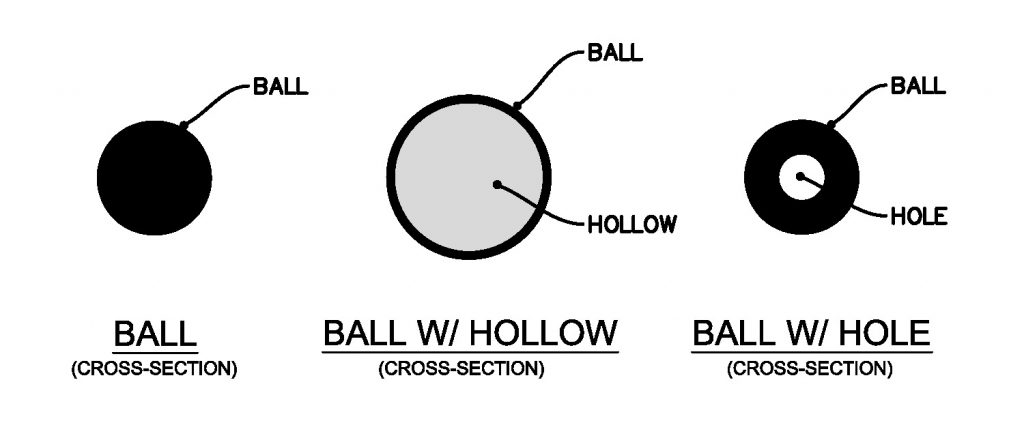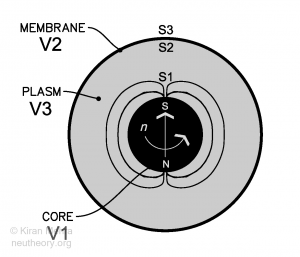The Primal Prototype Object of Nature
Primal Form
Primitive Shapes in Nature
All elementary matter and energy particles in nature are made from the following two primitive shapes.
The magnetic field has the primitive shape of a donut or:
- torus (ball w/ one hole)

The Primal Prototype Object of Nature
The three primitive shapes combine together to make one composite object similar to an egg or a cell. This is the ordinary neutron. All physical structures in nature are made from a large number of these primal cells that must exist in one of two physical states, the a-state as the neutron or the b-state as the hydrogen atom.
The Neutron Cell
The ordinary neutron is hypothesized as the primal prototype object of nature, the a-state. The neutron is completely neutral. There is no evidence of any electric charge within the body of a neutron. The neutron has the topology of a simple 3 part cell with the dynamic properties of:
- a spinning magnetic core
- a g-rise/spinfield that varies with size

The neutron cell is made up of 3 primal physical volumes defined by 3 primal physical surfaces that are topologically bound together as a quantum state of primal physical form. See Figure 0.4.
- V1 is the neutron core volume [1a] (ball shape) defined by the primal S1 surface with area A1. V1 & A1 are natural constants. The empirically measured charge radius of the proton (~0.841 x 10-15 m) is set as the basis for the physical standard for atomic volume (2.499 063 x 10-45 m3). The neutron core is hypothesized to have the same mass (1.672 631 x 10-27 kg) and volume (2.499 063 x 10-45 m3) as the proton. The neutron core can be simply considered as the perpetual one-way spin of a one surface (S1) physical body consisting of a homogeneous drop of Type I spinrise matter at an absolute density (6.693×1017 kg/m3). The perpetual spin of the neutron core matter generates a permanent magnetic moment (-0.966 236 x 10-26 J T-1) with the north magnetic pole “anti-parallel” to the core spin axis. The neutron core’s right hand spin axis (north up) along with its (north down) magnetic polarity provides a permanent primary direction of reference in nature.
- V2 is the neutron membrane volume [2a] (ball w/ one hollow or shell shape) contained between the primal S2 – S3 surfaces with areas A2 and A3. The two surfaces define a shell thickness “t.” V2 is a natural constant. The primal surface areas A2 -A3 and the shell thickness t are natural variables. The neutron membrane can be visualized as a non-spinning two surface body (S2-S3) consisting of a fixed volume (0.001 36 x 10-45 m3) of an uniformly thick homogenous layer of Type I spinrise matter (9.109 382 x 10−31 kg) at an absolute density (6.693×1017 kg/m3) that completely touches the neutron plasm surrounding the spinning core.
- V3 is the neutron plasm volume [3a] (topologically confined shell) contained between the primal S1 surface area of the core and the primal S2 surface area of the membrane hollow. V3 is a natural variable. The neutron plasm is the non-spinning substance contained within the hollow part (V3) of the ball w/ hollow shape. The substance is homogenous Type II spinrise matter (13.952 x 10-31 kg) that completely fills the entire volume between the spinning core and the non-spinning membrane. As the containment volume changes the plasm spinrise matter density changes. See Neu Mass & Charge Radii Table for nuclide volume and neucleon plasm density values.
Dynamic Properties
G-Spin/Magnetism
The neutron magnetic dipole field (ball w/ one hole shape) is generated by the absolute density matter core spinning at the accelerating speed of absolute movement. This is a natural movement/synergy field that projects a magnetomotive force into space that varies in strength inversely with the square of the distance away from the spinning core.
- The magnetic dipole is permanently aligned with the spin axis.
- The magnetic strength and north/south polarity of the neutron is permanently fixed by nature.
G-Rise/Spinfield (Gravity)
All three volumes of neutron matter are subject to primal g-rise acceleration-in-place. This g-rise acceleration-in-place is the source of the phenomena we call “gravity.” The acceleration-in-place starts at the S1 surface of the core. As the core is at absolute density with a fixed mass and volume, the g-rise value is also fixed at 1.57 x 10-7 m/s2. The g-rise acceleration-in-place value at the outer S3 surface of the membrane varies with the overall volume of the neutron.
The acceleration-in-place projects a spinfield into space.
In the Neu Theory model the spinfield has the same effect as the “spacetime” of Einstein’s General Relativity Theory. The crucial difference is the nature of space and time itself:
- In General Relativity spacetime is the “bending” or “warping” of space itself by the presence of mass. The greater the mass contained within a unit volume the larger the warp and slower the flow of time.
- In Neu Theory the spinfield, like every other field in nature, is a projection into space, that does not change the underlying properties of space itself. In Neu Theory space is a substance, i.e., a homogenous volume of free rise energy that isotropically expands and diffuses-in-place at the accelerating speed of absolute movement. Rise energy is a permanent “straight” one-way movement that cannot change. Space never bends, and the flow of time is the natural acceleration constant a.
